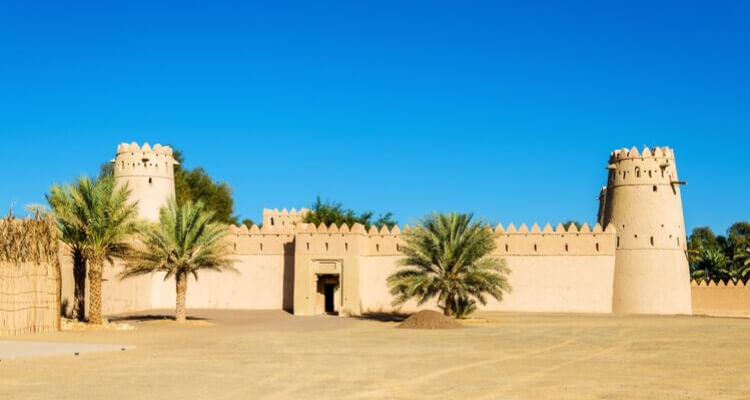Also known as the Oasis City or the Garden City, Al Ain in the second-largest city in the Emirate of Abu Dhabi and home to a huge amount of the UAE’s culture and history, dating back some 5,000 years to the Neolithic period.
Sitting on the border with Oman, Al Ain is a great day trip location from Dubai and home to the UAE’s only current tangible UNESCO World Heritage Site – well, there are actually several of them – collectively known as the Cultural Sites of Al Ain.
We’re going to talk you through exactly what you can expect to find in Al Ain and how to organise a day trip or overnighter to the Oasis City, Al Ain from Dubai.
So why is Al Ain worth a visit?
Far more than just the UNESCO cultural sites, Al Ain has been at the crossroads of Arabian civilisation for centuries. The Bedouin would retreat from the coast to the desert during the hottest times of the year, with the natural oasis bringing a cooling reprieve.
In more recent times, the city is the birth home of the country’s founding father Sheikh Zayed Bin Sultan al Nayhan and the UAE’s present ruler HH Sheikh Khalifa Bin Zayed al Nayhan.
It is also the border crossing point in modern time to the Sultanate of Oman, sitting to the south of the city – a popular border crossing point for visitors looking to do border runs, or head onwards to Nizwa & Muscat.
Al Ain houses many museums which seek to document the country’s past and are well worthy of being included on an Al Ain road trip, sites to consider include:
- Al Ain Palace Museum
- Qasr al Muwaiji
- Al Jahili Fort
- Al Ain National Museum (currently closed for renovations)
- Souk Al Qattara (Thu, Fri & Sat evenings October to May)
- Al Ain Camel Market
- Sheikh Zayed Desert Learning Centre, inside Al Ain Zoo
If you are interested to learn more about the Al Ain Zoo, amusement parks and family activities on offer in Al Ain, check out this detailed family guide to Al Ain.
Tour Suggestion: Take a Guided Tour of Al Ain from Dubai

Cultural Sites of Al Ain – A UNESCO World Heritage-listed site Ref 1343
Although consisting of only one listing, The Al Ain sites are, in fact, made up of several sites; Hafit, Hili, Bidaa Bimt Saud and Oases Areas.
These sites testify to human occupation of the desert region since the neolithic period with vestiges of many prehistoric cultures – notable the Bronze Age and The Iron Age. Remarkable vestiges include:
- Circular stone tombs (dated back to c2500 BC)
- Residential buildings, towers, palaces and administrative buildings
- Examples of the earliest aflaj irrigation system
You can read more about the UNESCO World Heritage Inscription here.
Let’s look at each of the sites in more detail:
READ MORE 8 Awe-Inspiring Art Galleries in Dubai
The Oasis of Al Ain

There are several Oasis in Al Ain that make up the UNESCO World Heritage Site, namely:
- Al Ain Oasis
- Al Muatared Oasis
- Al Jimi Oasis
- Al Qattara Oasis
- Al Hili Oasis
The largest is Al Ain Oasis which can be found in the very centre of the city of Al Ain. Extensive restoration works took place on the site over the last decade which reopened to the public in 2016 and is now the city’s most popular attraction.
A tranquil forest of trees and alleyed laneways, it was nearly lost beneath the city as rapid development occurred in the 1980s and 1990s. The 3,000-acre site (1,200 hectares) contains more than 147,000 palm trees. You will also find within the grounds an old fortification and mosque.
The falaj system is what most visitors are intrigued by; an ancient irrigation system bringing bore water to farms. A small Eco-Centre has been built within the Al Ain Oasis to provide more information on the history and importance of the falaj.
Just outside of the oasis is the Al Ain Oasis Plaza which is open until 9pm at night for refreshments.
The Oasis is open 8am to 5pm daily and free to enter.
Jebel Hafeet Bee Hive Tombs
Found at the foot of Abu Dhabi’s highest peak Jebel Hafeet, the circular Bee Hive Tombs are thought to date back up to 5,000 years. The artefacts found within the tombs has helped archaeologists to substantiate claims of trade routes dating to around 3,200 to 2,700 BCE.

Since February 2020, the tombs now fall within the Jebel Hafit Desert Park. Hiking and biking are available, along with camel rides, dune buggy experiences and even overnight camping in Bedouin-style tents and eco glamping options.
Open 8am to 6pm or sunset, entry 5AED activities extra.
Hili Archaeological Park
Home to the largest discovered Bronze Age settlement in the UAE, the park is a living museum of tombs, settlements and a falaj – mostly it is only foundations that can be spotted today. Most items of significance having been moved to the central Al Ain National Museum (which is closed for an unspecified period of time for renovations) in the centre of Al Ain, adjacent to the Al Ain Oasis.
The park is open limited hours 4pm to 11pm daily, entry is free.

Bidaa Bimt Saud
There are several small finds near one another contributing to this archaeological site, sitting about 15kms to the north of Al Ain:
- Numerous rectangular, stone-constructed tombs from the Hafit period (3200 to 2600 BC) on top of a mountain called Gharn bint Saud
- 1,500 metres to the west is a 3,000-year-old falaj system
- A large mudbrick building with column bases was found near the falaj, thought to perhaps be a distribution point for the falaj
This site is quite isolated and not easily accessible to the public. Finds from the site are also housed in the Al Ain National Museum. You can learn more about this site on abudhabiculture.ae
READ MORE Swing your way through Aventura Park Dubai
Open 24/7, entry is free.
How to get to Al Ain From Dubai
You have a few choices in driving to Al Ain – self-drive or with a tour/driver or taking the public bus.
Although you are crossing from Dubai Emirate into Abu Dhabi Emirate, there is no formal border crossing involved, just large expanses of highway through the desert.
Public Bus to Al Ain from Dubai
The bus from Dubai – Route E201 – departs from Al Ghubaiba bus station every 30 minutes and costs 25AED one way. The bus passes through:
- Al Jafiliya Metro Station – north
- Wasl
- Wasl Club 1
- Emirates NBD – Nad Al Sheba
- Marmoom Dairy Farm 1
- Al Faqa station 1
- UAE University Mohammed bin Khalifa Street 1
- City Petrol Station 1, and
- Sheikha Salama Mosque 1
And terminates at Al Ain Central Bus Station, which is adjacent to the Al Ain Oasis. To see more of the outlying UNESCO World Heritage sites, you would need a taxi or private car.
The bus then runs in return from Al Ain Central Bus Station to Dubai Al Ghubaiba Bus Station every 30 minutes, 25AED.
The journey takes a bit over 2 hours in each direction.
Private Car to Al Ain
You can hire your own car in Dubai and drive to Al Ain if you are confident behind the wheel.
Getting out of Dubai is the challenging part if you’re not used to 6 lane freeways and very fast-moving traffic! Once you hit the E66 though, it’s easy multi-lane driving. You should get there in only around an hour from the city centre.
- We recommend you look at DiscoverCars to find the cheapest car hire options in Dubai.
- If you’d prefer to have a driver, try GetTransfer. You simply enter your destination details on their app and what sort of vehicle you need and drivers can bid for your custom. You’d be wise to take out a full-day hire to cover all the sites we’ve listed here.
Tour Companies from Dubai to Al Ain
There are surprisingly few tour operators taking guests from Dubai to Al Ain’s UNESCO World Heritage Sites daily. You will find tours normally incorporate not only the UNESCO sites but al Jahili Fort and numerous museums.
- Try this tour from Dubai to Al Ain
Staying in Al Ain – Best Accommodation
Al Ain has a reasonable range of accommodation options if you are looking to extend your trip to Al Ain. You will certainly need more than two days to capture all the highlights of the Oasis City.
READ MORE Day Trip to the Grand Mosque from Dubai the easy way
Most resorts and hotels are a little dated but you can find a bargain resort retreat, our favourites are:
- Al Ain Rotana – the best central option near to Al Jahili Fort and several dining options including Trader Vics make this a great all-rounder option for couples and groups – check prices on Booking.com
- Mecure Grand Jebel Hafeet – for a spectacular view, look to head to the top of Abu Dhabi Emirates’ highest peak Jebel Hafeet. The hotel is a little dated but has a great range of facilities – check prices on Booking.com
- Danat Al Ain Resort – an oldie but a goldie this family resort is still packed with fun and can offer some great weekend packages – check prices on Booking.com
- Aloft Al Ain – comfortable modern accommodation adjacent to the Hazza Bin Zayed Stadium with several dining options – check prices on Booking.com
You can find a full selection of hotel & VRBO options for Al Ain here:
Like much of the country, the cooler winter months are ideal for exploring Al Ain from November through to April. The summer months it is still possible, and the oases do bring a refreshing reprieve from the summer heat but be prepared it can still be a very sweaty experience in the summer.
In the winter, Al Ain can experience quite heavy fog, which plays havoc on the highways to Al Ain from Dubai and Abu Dhabi. It normally burns off before lunchtime, leaving you with glorious sunny winter afternoons and perfect sunsets from Jebel Hafeet.
 The mountainous landscape of Al Ain at sunset
The mountainous landscape of Al Ain at sunset
This guide was first written in October 2019 and has been updated to reflect the post-COVID situation in the UAE in 2022.













